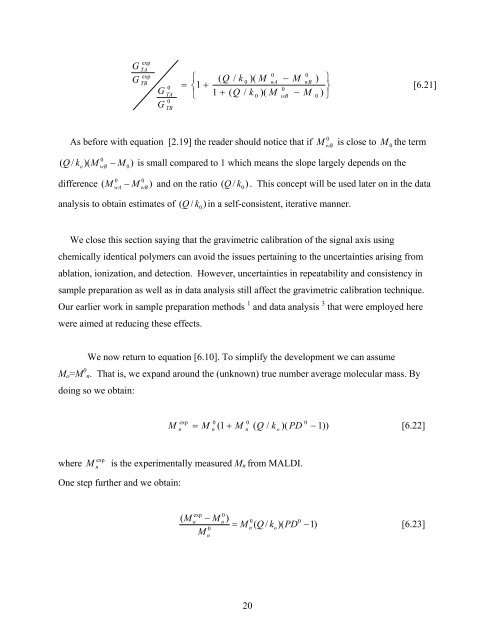Standard Reference Material 2881 - National Institute of Standards ...
Standard Reference Material 2881 - National Institute of Standards ...
Standard Reference Material 2881 - National Institute of Standards ...
You also want an ePaper? Increase the reach of your titles
YUMPU automatically turns print PDFs into web optimized ePapers that Google loves.
GGexpTAexpTBGG0TA0TB=⎧⎨1+⎩0( Q / k0)( MwA1 + ( Q / k )( M0−0wB0MwB− M))0⎫⎬⎭[6.21]0As before with equation [2.19] the reader should notice that if is close to M the termMwB00( Q / ko)(MwB− M0)is small compared to 1 which means the slope largely depends on the0 0difference ( M − M ) and on the ratio Q / k . This concept will be used later on in the datawAwB(0)analysis to obtain estimates <strong>of</strong>( Q / k0)in a self-consistent, iterative manner.We close this section saying that the gravimetric calibration <strong>of</strong> the signal axis usingchemically identical polymers can avoid the issues pertaining to the uncertainties arising fromablation, ionization, and detection. However, uncertainties in repeatability and consistency insample preparation as well as in data analysis still affect the gravimetric calibration technique.Our earlier work in sample preparation methods 1 and data analysis 3 that were employed herewere aimed at reducing these effects.We now return to equation [6.10]. To simplify the development we can assumeM o =M 0 n. That is, we expand around the (unknown) true number average molecular mass. Bydoing so we obtain:exp 000Mn= Mn(1 + Mn( Q / ko)( PD − 1))[6.22]whereexpM nis the experimentally measured M n from MALDI.One step further and we obtain:( 0exp 0Mn− Mn) 0= M ( Q / k )( PD −1)0n o[6.23]Mn20
















